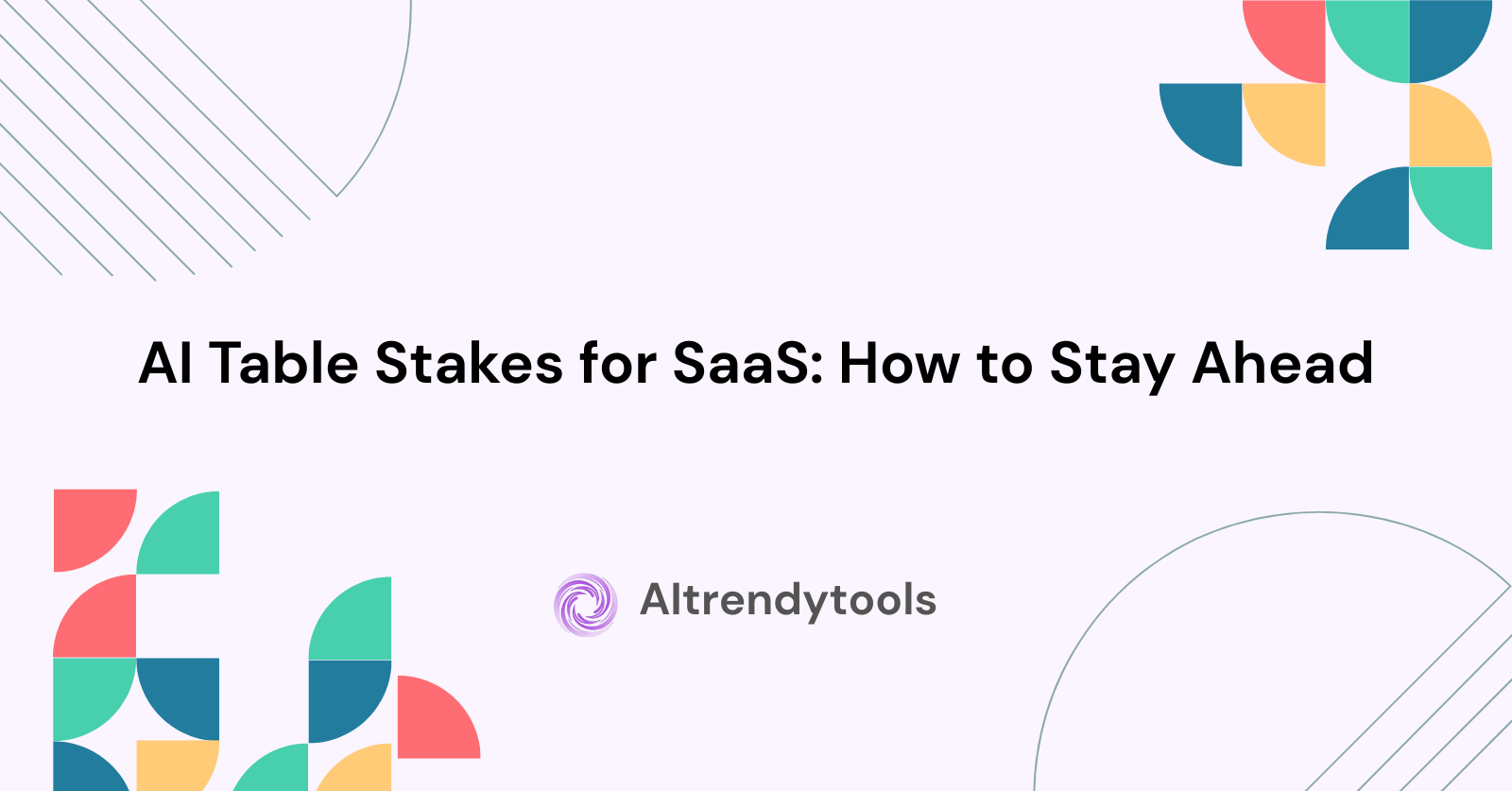🔥 AITrendytools: The Fastest-Growing AI Platform |
Write for usAI Table Stakes for SaaS: How to Stay Ahead
Discover why AI is now table stakes for SaaS companies. Learn proven strategies to stay ahead, reduce costs by 30%, and boost revenue by 25%
Oct 17, 2025
The software-as-a-service industry has reached a critical inflection point. Companies without artificial intelligence capabilities face an uphill battle against competitors who have already integrated smart features into their products.
Customer expectations have fundamentally shifted. Users now demand intelligent, automated, and personalized experiences as standard offerings. The question is no longer whether to adopt AI but how to implement it strategically to maintain market leadership.
Understanding AI as Table Stakes in Modern SaaS
The term "table stakes" refers to minimum requirements necessary to compete in a market. AI features have crossed this threshold in the SaaS landscape.
Current Market Reality:
- 78% of SaaS buyers consider AI features essential when evaluating new software
- Basic functionality alone no longer justifies subscription fees
- Customers evaluate products based on learning, adaptation, and automation capabilities
- Features that seemed innovative two years ago now appear standard
Every software company now faces pressure to demonstrate intelligent capabilities. The baseline has shifted dramatically. Companies must continuously evolve their AI offerings to avoid falling behind market expectations.
AI-Powered SaaS: Beyond Basic Chatbots
Many companies mistakenly believe that adding a chatbot satisfies AI requirements. This superficial approach fails to deliver the transformative value customers seek.
True AI integration goes much deeper than conversational interfaces. The technology should permeate core product functionality, enhancing every aspect of the user experience.
Basic Chatbots vs. Advanced AI Systems:
Basic Chatbots:
- Handle simple queries
- Route requests to appropriate departments
- Provide canned responses
- Operate within limited scope
Advanced AI Systems:
- Analyze complex patterns across user behavior
- Predict outcomes before problems arise
- Execute multi-step workflows autonomously
- Continuously learn and improve performance
A "thinking engine" represents the gold standard for AI implementation. These systems anticipate needs before they arise and automate complex decision-making processes. Companies investing in surface-level AI risk losing ground to competitors building intelligence into their product foundation.
AI-First Product Development Strategies
Building AI capabilities into existing products differs significantly from designing software with intelligence at its core. The AI-first approach yields superior results.
Product teams should begin every feature discussion by asking how AI can enhance functionality. This mindset shift transforms development priorities and resource allocation decisions.
Key Components of AI-First Development:
- Data Infrastructure
- Efficient collection and organization systems
- High-quality data processing pipelines
- Secure storage with proper governance
- Seamless access for machine learning algorithms
- API Architecture
- Models need direct access to relevant data sources
- Security protocols that don't hinder performance
- Scalable infrastructure for growing demands
- Integration capabilities with external services
- User Interface Design
- AI suggestions feel intuitive rather than intrusive
- Intelligent features become invisible to users
- Natural accommodation of automated workflows
- Clear value demonstration without overwhelming complexity
Poor data quality undermines even the most sophisticated AI models. User interface design must make intelligent features accessible without creating friction.
Customer Personalization Through Machine Learning
Generic software experiences no longer satisfy modern users. Machine learning enables unprecedented levels of customization based on individual behavior patterns.
Personalization algorithms analyze how each user interacts with software. The system identifies preferences, common workflows, and pain points automatically.
Industries Leading in Personalization:
Email Marketing Platforms:
- Analyze past campaign performance metrics
- Suggest optimal send times for each segment
- Recommend subject lines based on audience behavior
- Adapt content strategies to engagement patterns
Project Management Software:
- Learns which features each team member uses frequently
- Adjusts dashboards based on individual working styles
- Prioritizes tasks according to project patterns
- Predicts deadline risks before they become critical
Netflix and Spotify have set consumer expectations for personalized experiences. B2B SaaS users now demand similar treatment in their professional tools. Companies failing to deliver face customer churn.
Predictive Analytics and Intelligent Automation
Looking backward at historical data provides limited value compared to anticipating future needs. Predictive analytics transforms SaaS products from reactive tools into proactive business partners.
Applications Across Business Functions:
Inventory Management:
- Forecasts demand based on seasonal trends
- Analyzes economic indicators for purchasing decisions
- Prevents stockouts through early warnings
- Reduces excess inventory carrying costs
Customer Relationship Management:
- Identifies accounts at risk before warning signs appear
- Triggers proactive engagement sequences automatically
- Improves retention rates through early intervention
- Prioritizes sales team focus on high-value opportunities
Financial Software:
- Predicts cash flow challenges weeks in advance
- Enables informed decisions about hiring and investment
- Optimizes expense management timing
- Models scenario outcomes for strategic planning
Intelligent automation extends beyond simple task repetition. Modern AI systems handle complex workflows requiring judgment and adaptation. Document processing, data entry, report generation, and quality control all become automated.
AI Implementation for Customer Retention
Acquiring new customers costs five to seven times more than retaining existing ones. AI dramatically improves retention metrics through early intervention and enhanced value delivery.
Behavioral analysis identifies usage patterns correlated with churn risk. A customer who stops logging in daily triggers automated engagement sequences.
Retention Strategies Powered by AI:
- Proactive Support: Detects when users struggle with features and offers contextual guidance immediately
- Personalized Recommendations: Helps users discover valuable capabilities they didn't know existed
- Optimized Onboarding: Adapts tutorials based on user role, industry, and technical proficiency
- Usage Monitoring: Identifies declining engagement patterns before customers decide to leave
- Value Demonstration: Shows concrete ROI metrics specific to each customer's usage
This invisible assistance improves satisfaction without requiring additional support staff. The software becomes more indispensable over time rather than stagnating. Customers achieve results faster, reducing early-stage churn.
Vertical SaaS Solutions and AI Integration
Horizontal SaaS platforms serve broad markets with generalized functionality. Vertical solutions target specific industries with specialized features tailored to unique workflows and compliance requirements.
AI amplifies the advantages of vertical specialization. Industry-specific data models, terminology, and business rules enable more accurate predictions and relevant automations.
Industry-Specific AI Applications:
Healthcare SaaS:
- Trained on medical terminology and diagnostic codes
- Understands treatment protocols and clinical workflows
- Improves documentation accuracy and billing precision
- Enhances patient communication with contextual awareness
Construction Management:
- Incorporates building codes and material costs
- Anticipates project delays based on historical patterns
- Optimizes resource allocation for multiple job sites
- Suggests mitigation strategies for common challenges
Legal Technology:
- Trained on case law and contract language
- Automates document review with high accuracy
- Accelerates research across regulatory requirements
- Identifies compliance risks automatically
The data moat created by vertical specialization provides sustainable competitive advantages. Competitors cannot easily replicate models trained on years of industry-specific information. Generic software misses context that specialized solutions capture naturally.
Cost Reduction and Revenue Growth with AI
Financial justification remains essential for AI investment decisions. The technology delivers measurable returns across multiple business dimensions.
Documented Financial Impact:
- Operational cost reductions: Up to 30%
- Revenue increases: 25% or more
- Development velocity improvements: 40% faster feature delivery
- Customer acquisition costs: 20-35% reduction
Cost Reduction Mechanisms:
Automation eliminates manual labor for repetitive tasks. Customer support efficiency improves as AI handles routine inquiries. Infrastructure costs decrease through intelligent resource allocation and optimization. Development teams ship features faster with AI-assisted coding and testing.
Revenue Growth Drivers:
AI-powered lead scoring helps sales teams focus efforts on high-probability prospects. Product recommendations drive upsells and cross-sells automatically. Churn reduction directly impacts recurring revenue. Pricing optimization maximizes revenue without sacrificing conversion rates.
Real-Time Insights and Data-Driven Decisions
Business intelligence traditionally relied on backward-looking reports generated periodically. Modern AI enables continuous monitoring and immediate insights that drive faster, better decisions.
Dashboard automation eliminates manual report creation. Metrics update constantly, providing current views of business performance.
Real-Time Capabilities:
- Anomaly Detection: Highlights issues requiring attention while filtering normal fluctuations
- Natural Language Queries: Non-technical users explore data independently in plain English
- Competitive Intelligence: Tracks market movements and pricing changes continuously
- Automated A/B Testing: Allocates traffic and detects statistical significance automatically
- Predictive Alerts: Warns about potential problems before they impact customers
Natural language query interfaces allow executives to ask questions and receive visual answers immediately. Democratized data access improves decision-making throughout organizations. Product teams run more tests and learn faster about user preferences.
Building a Competitive Advantage in AI SaaS
Meeting baseline AI expectations prevents falling behind but doesn't create market leadership. True competitive advantage requires strategic differentiation in how AI capabilities are developed and deployed.
Sustainable Differentiation Strategies:
1. Proprietary Data Assets Companies with unique datasets train models that competitors cannot replicate. Customer data, industry-specific information, and behavioral patterns become increasingly valuable over time. The data moat strengthens with every user interaction.
2. Domain Expertise Embedding Understanding industry nuances, regulatory requirements, and workflow complexities allows companies to build superior solutions. Generic AI cannot match specialized knowledge. Subject matter experts working with data scientists create unbeatable combinations.
3. Innovation Speed Organizations that iterate quickly on AI features stay ahead of slower competitors. Agile development processes, experimentation cultures, and rapid deployment capabilities all contribute to maintaining leadership positions. Market timing advantages compound over multiple product cycles.
4. User Experience Excellence The best algorithms fail if interfaces confuse users or interrupt workflows awkwardly. Companies excelling at UX design capture disproportionate value from their AI investments. Intuitive implementations drive adoption and satisfaction.
5. Strategic Partnerships Integrations with complementary tools, data providers, and technology platforms create network effects. Partnership ecosystems extend AI capabilities beyond internal development resources. Collaborative advantages strengthen competitive positions.
Practical Steps to Stay Ahead of the Baseline
Strategy without execution means nothing. SaaS companies need concrete action plans for advancing their AI capabilities systematically.
Identify High-Impact Opportunities
Not every business function benefits equally from AI investment. Start by analyzing where intelligent automation or prediction delivers maximum value.
How to Prioritize AI Projects:
- Survey existing customers about pain points and desired features
- Analyze support ticket volumes to identify common frustrations
- Review user behavior data for workflow inefficiencies
- Calculate potential ROI for different implementation areas
- Consider technical feasibility and resource requirements
Customer support, sales operations, and product recommendations typically offer quick wins. Build what customers will actually use rather than pursuing technically interesting but commercially irrelevant projects.
Build Data Infrastructure First
AI models require clean, organized, accessible data. Many companies attempt to implement AI before establishing proper data foundations.
Essential Infrastructure Components:
- Data governance policies ensuring quality and security
- Pipelines moving information efficiently between systems
- Schemas facilitating analysis and model training
- Compliance frameworks for regulatory requirements
- Access controls balancing security with usability
This approach inevitably fails without proper groundwork. Establish foundations before attempting advanced implementations.
Start Small and Measure Results
Attempting comprehensive AI transformation simultaneously across all product areas overwhelms resources and creates unnecessary risk. Choose one specific use case, implement it well, and measure outcomes rigorously.
Success Metrics to Track:
- User adoption rates for new AI features
- Customer satisfaction scores before and after implementation
- Efficiency gains measured in time or cost savings
- Financial impact on revenue or margins
- Technical performance metrics like accuracy and speed
Define success metrics before beginning development. Use results to justify expanded AI investment and inform prioritization of subsequent projects.
Hire or Develop AI Expertise
Building competitive AI capabilities requires specialized skills. Data scientists, machine learning engineers, and AI product managers bring essential knowledge to development teams.
Talent Acquisition Options:
- Full-time hires for long-term capability building
- Consultancy partnerships for specific projects
- Fractional experts providing ongoing guidance
- Training programs for existing employees
- University partnerships for research collaboration
For companies unable to hire full-time AI specialists, partnerships with consultancies provide access to needed skills. Online courses and certification programs help existing employees develop AI competencies gradually.
Foster an Experimentation Culture
AI development involves uncertainty and iteration. Not every model performs as expected initially.
Organizations must embrace experimentation and tolerate intelligent failures during the learning process. Create safe spaces for testing new approaches without fear of negative consequences. Celebrate learning from unsuccessful experiments. Encourage rapid prototyping and quick pivots based on results.
Monitor Industry Developments
The AI landscape evolves constantly. New models, techniques, and applications emerge regularly.
Staying Informed:
- Subscribe to industry newsletters covering AI advances
- Follow thought leaders sharing insights on social platforms
- Attend conferences focused on AI in SaaS
- Participate in online communities discussing implementations
- Dedicate team time for exploring emerging technologies
Companies must stay informed about relevant advances and assess their potential impact on competitive positioning. Dedicate time for team members to evaluate applicability to your products.
Communicate Value Clearly
Customers need to understand how AI features benefit them specifically. Technical capabilities mean nothing if users don't recognize value or know how to access it.
Effective Value Communication:
- Create educational content explaining functionality in simple terms
- Show concrete examples of time saved and outcomes improved
- Make features discoverable through clear labeling
- Provide contextual prompts within product interfaces
- Demonstrate ROI with personalized usage metrics
Marketing materials should focus on business outcomes rather than technical specifications. Users care about solving problems, not about the algorithms running behind the scenes.
Preparing for the AI-Native Future
The next generation of SaaS products will be AI-native from inception rather than AI-enhanced after the fact. Companies building with this mindset today establish strong positions for long-term success.
Emerging Trends Shaping the Future:
Voice Interfaces Natural language processing improvements will make conversation the primary interaction model. Users will talk to software instead of clicking through menus. Products must be designed to support this fundamental shift.
Autonomous Agents Agent-based architectures will enable software that takes actions independently on users' behalf. Rather than providing tools for humans to use, AI agents will complete entire workflows. This changes product design and value propositions fundamentally.
Continuous Learning Systems Software will evolve automatically based on usage patterns and feedback without requiring manual updates. The boundary between product and service will blur further. Improvements happen invisibly and continuously.
Industry Consolidation AI development costs favor larger companies with resources and data advantages. Smaller SaaS providers will need to find defensible niches or partner strategically. Market dynamics reward scale in AI-powered competition.
Regulatory Frameworks Policy around AI will mature, creating compliance requirements that shape product development. Companies must monitor developments and build responsibly. Legal challenges await organizations ignoring ethical considerations.
FAQ
Is AI really necessary for all SaaS companies?
AI has become essential for remaining competitive in most SaaS markets. Customers expect intelligent features as standard offerings. Companies without AI capabilities face significant disadvantages in customer acquisition and retention.
How much does implementing AI in SaaS cost?
Costs vary widely based on scope and complexity. Small implementations start around $50,000-$100,000. Comprehensive AI integration can require millions in investment. Most companies see positive ROI within 12-18 months through cost reductions and revenue growth.
Can small SaaS companies compete with large enterprises in AI?
Small companies can compete by focusing on vertical specialization and niche markets. Industry-specific expertise combined with targeted AI applications creates defensible positions. Strategic partnerships extend capabilities without massive internal investment.
What's the difference between basic AI and advanced AI in SaaS?
Basic AI includes simple chatbots and rule-based automation. Advanced AI involves machine learning models that improve continuously, predictive analytics, and intelligent systems that make complex decisions autonomously. The value difference is substantial.
How long does it take to implement AI in a SaaS product?
Simple AI features take 3-6 months to develop and deploy. Comprehensive AI integration spanning multiple product areas requires 12-24 months. Starting with focused use cases and expanding systematically works best.
Will AI replace human workers in SaaS companies?
AI augments human capabilities rather than replacing workers entirely. Repetitive tasks become automated, freeing teams to focus on strategic work requiring creativity and judgment. Roles evolve as AI handles routine operations.
What data do I need to start implementing AI?
Clean, organized historical data showing user behavior, outcomes, and patterns. Most companies need at least six months of quality data before training effective models. Data infrastructure should be established before attempting AI implementation.
How do I measure AI success in my SaaS product?
Track user adoption rates, customer satisfaction scores, efficiency gains, and financial impact. Compare metrics before and after AI implementation. Focus on business outcomes rather than technical performance alone.
Conclusion
AI has definitively become table stakes for SaaS companies competing in 2025 and beyond. Customers expect intelligent features as standard offerings rather than premium add-ons.
Meeting baseline expectations requires more than superficial AI implementation. Companies must integrate machine learning deeply into product cores, creating thinking engines that learn, adapt, and anticipate user needs proactively.
Key Takeaways:
- 78% of SaaS buyers consider AI essential when evaluating software
- AI drives 30% cost reductions and 25% revenue increases
- Vertical specialization amplified by AI creates sustainable advantages
- AI-first development outperforms retrofitting existing products
- Continuous innovation separates market leaders from followers
Staying ahead of the baseline demands strategic focus on areas delivering maximum customer value. Personalization, predictive analytics, and intelligent automation represent high-impact opportunities for most SaaS businesses.
The future belongs to AI-native products designed from inception with intelligence at their foundation. Organizations building toward this vision today position themselves for sustainable success in an increasingly competitive landscape.
The baseline will continue rising. What seems advanced today will become expected tomorrow. Continuous innovation and strategic focus separate market leaders from followers in the AI-powered SaaS revolution.
🚀 Submit Your Tool to Our Comprehensive AI Tools Directory
Get your AI tool featured on our complete directory at AITrendytools and reach thousands of potential users. Select the plan that best fits your needs.





Join 30,000+ Co-Founders
Related Blogs
DreamFace: #1 AI Face Generator for Realistic Photos
Discover DreamFace, the leading AI face generator creating ultra-realistic portraits. Free & premium tools for creators, gamers & professionals. Try now!
TechMapz Com: 7 Reasons It's Your Best Tech Hub
Discover TechMapz com the ultimate technology hub for gadget reviews, AI trends, cybersecurity tips, and tech news. Explore features that make it stand out in 2025.
Sci Hub: 10+ Free Alternatives to Access Research Papers
Discover Sci Hub alternatives and 10+ legal ways to access research papers free. Complete guide to scientific journals, open access, and academic resources.
Submit Your Tool to Our Comprehensive AI Tools Directory
List your AI tool on AItrendytools and reach a growing audience of AI users and founders. Boost visibility and showcase your innovation in a curated directory of 30,000+ AI apps.





Join 30,000+ Co-Founders

